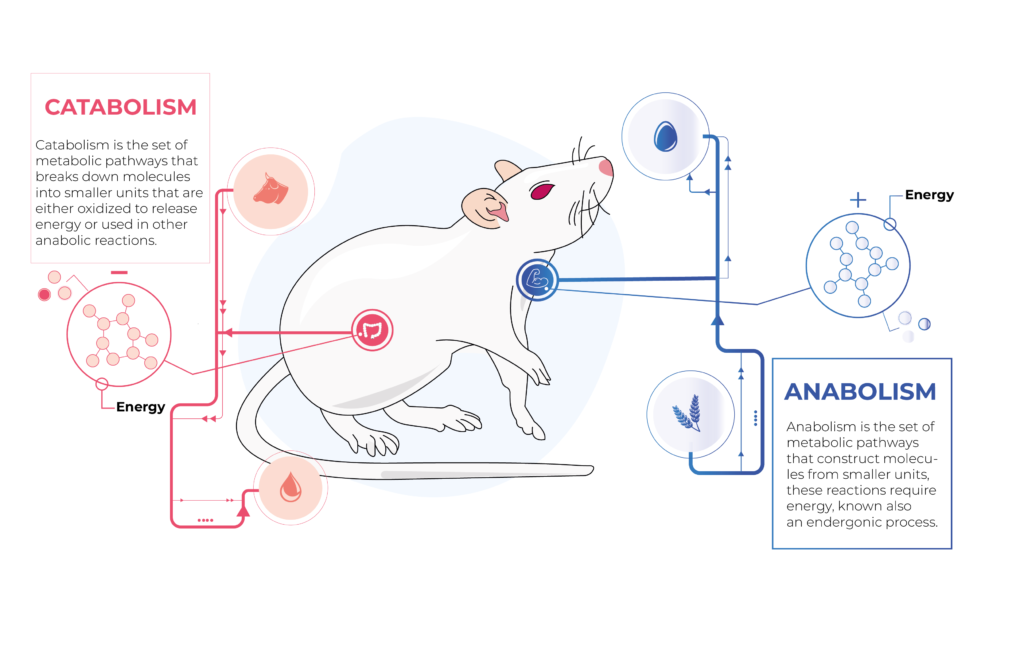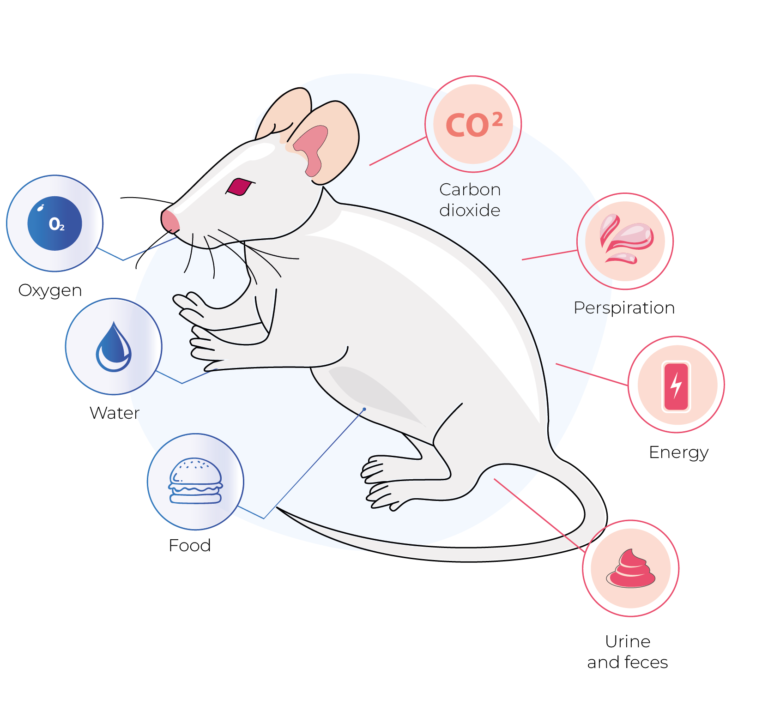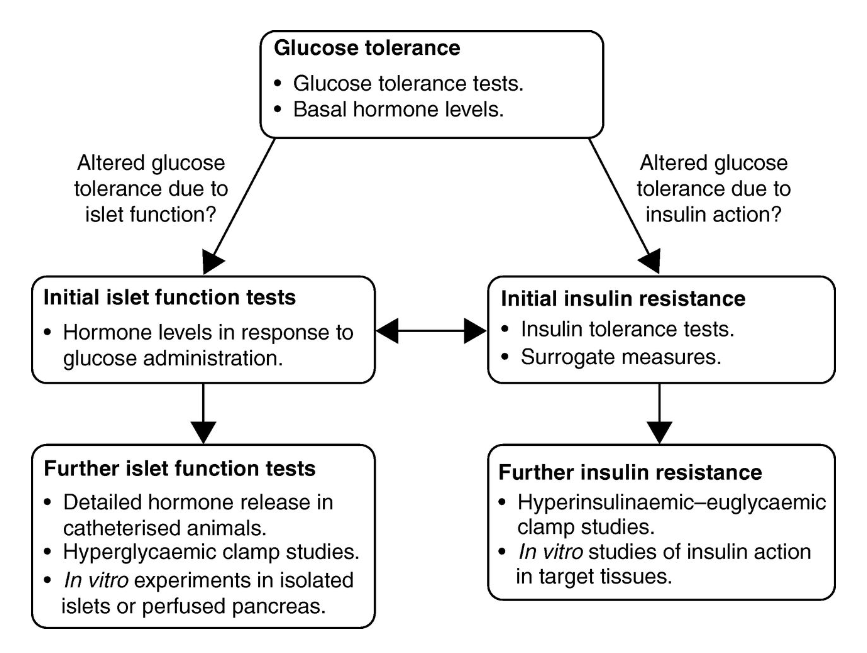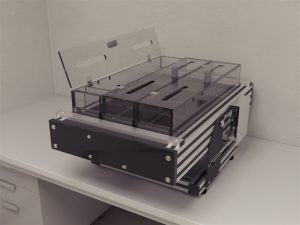To reference this article
Rodent Metabolism and Measurable Metabolic Parameters, Maze Engineers (2022). doi.org/10.55157/ME20221213
What are Metabolism and Measurable Metabolic Parameters in Rodents?
Metabolism is the sum of chemical reactions involved in sustaining the life of organisms.[1] It constantly provides your body with the energy to perform essential functions. The process is categorized into two groups:[2]
Catabolism:
It’s the process of breaking down molecules to obtain energy. For example, converting glucose to pyruvate by cellular respiration.
Anabolism:
It’s the process of synthesis of compounds required to run the metabolic process of the organisms. For example, carbohydrates, proteins, lipids, and nucleic acids.[2]
Metabolism is affected by a range of factors, such as age, sex, muscle mass, body size, and physical activity affect metabolism or BMR (the basal metabolic rate). By definition, BMR is the minimum amount of calories your body requires to function at rest.[2]
How is metabolism measured? In rodent animal models, there are multiple metabolic parameters that can be measured to determine the metabolic rate
Figure 1: Metabolic processes of catabolism and anabolism in rodents
What is Metabolism?
A thousand reactions take place in our body at any given time point to convert food and drink that we have into energy. It’s required to keep our cells healthy and functioning, thus our body thriving as a whole. All these reactions that our body uses to build and repair itself and keep us alive are known as metabolism.
The nutrients and substances that we intake act as building blocks for our growth and development, reproduction, and movement. The conversion reactions are facilitated by enzymes that are proteins with the specialized function of carrying out anabolism and catabolism reactions.[1]
A fun fact about metabolism is that the basic chemical reaction that creates metabolism is the same in all living organisms, including plants, animals, fungi, and bacteria.[1] The information of the enzyme carrying out these reactions is encoded by DNA (the hereditary material in most organisms).
Why metabolism is required?
- Conversion of food energy into cellular energy (Adenosine triphosphate (ATP) )
- Creating proteins, lipids, nucleic acids, and some carbohydrates from food
- Metabolic waste elimination[3]
Why Do We Study Metabolism in Rodents?
The study of metabolism or the metabolic pathway is essential primarily for two reasons:
- Quantifying the chemical changes catalyzed by the enzymes involved in the metabolic route
- To describe the intracellular controls that regulate the pathway’s activity rate.
Properly designed, carefully executed, and critically interpreted studies on rodent animal models can provide deeper insight into human health. The metabolic pathways of organisms show the metabolic disturbances and their vital role in regulating biological processes to understand the complexity of the organism.[4]
Though, millions of metabolic pathways and networks are present in our bodies. But, a few among them include glucose level modulation, mitochondrial function, and cardiac function. Any disruption of these pathways can result in the pathogenesis of metabolic diseases.[4] Thus, it’s essential to keep them healthy. You will be shocked to know that 66 million Americans and over 1 billion people globally are suffering from metabolic diseases.[4] This has created a profit boom for the healthcare industry, which is billions of dollars a year.
Additionally, patients and their families have also gone through enormous emotional burdens with financial burdens. For this reason, it is imperative to continue studying metabolism in healthy and diseased contexts to develop treatments and preventative measures against metabolic diseases.
How Can Metabolic Parameters Be Measured in Rodents?
The drivers of metabolic pathways must be identified and quantified to understand the diseases and conditions that arise due to metabolic nuances.[4] There is a range of metabolic tests and procedures available to indicate the metabolic health of organisms. These tests provide insight into the elements of the metabolic pathways and their concentration in particular cellular regions.[4] Among many, some of the tests to measure metabolic indicators include the following [5]:
Maximum Volume of Oxygen (VO2 Max)
The test explains how effectively your body uses oxygen during exercise and any other physical activity. At different intensities and levels, the tests show heart rates ideal for burning calories. This improves overall cardiovascular or heart health and overall fitness status [5]. See our article on measuring VO2 Maze here.
Resting Metabolic Rate (RMR)
This shows the number of calories burned while your body is at rest (not exercising or physically engaged). The test helps in determining the calorie intake and energy balance recommended for your body. It also explains your resting energy expenditure (REE), which can be used to calculate the calories required to maintain weight or add muscle mass. It helps your nutritionist to set an exercise or diet program based on your body type.[5]
Lactate Threshold Test
The lactate threshold is the point at which the lactate builds in our body at a faster rate compared to the speed it is removed during exercise. It leads to muscle fatigue. It’s one of the most common tests used for athletes to determine their metabolic activity[5]. See our article on measuring the rodent lactate threshold here.
Comprehensive Metabolic Panel (CMP)
It’s a blood test that includes 14 different measurements. With metabolic activity, the test also displays your kidney and liver functional status and nutrient levels. In hospitals, the test is used to assess patients’ health.[5]
- Calcium: It has roles in bone health, muscle contraction, and nerve signaling. A low calcium level shows kidney, liver, and thyroid conditions.
- Sodium: It’s an electrolyte that balances the concentration of acid and base in our body. Abnormal sodium levels indicated health conditions related to the kidney, high blood pressure, or dehydration.
- Bicarbonate: It’s an electrolyte that reflects the CO2 level in your blood.
- Potassium: It’s a key electrolyte whose disbalance leads to diseases like hyperglycemia, altered excretion, and hyperkalemia.
- Chloride: It’s also an electrolyte that works in conjunction with potassium, sodium, and bicarbonate.
- Glucose: Metabolic problems, like diabetes or pre-diabetes, increase the blood sugar level.
- Blood urea nitrogen (BUN): It measures the urea nitrogen level, which is filtered by the kidneys. A high BUN level shows heart problems, kidney disease, and dehydration.
- Albumin: This protein transports nutrients across the body and prevents blood vessels from leaking fluid. A disturbed albumin level shows kidney disease.
- Creatinin: It’s a waste product released from the kidney. A disturbed creatinine level shows kidney disorders.
- Total Protein: It measures the sum of albumin and globulin proteins. These are the proteins related to immune functions and blood vessels.
- Aspartate aminotransferase (AST): Disturbance in this enzyme sow liver dysfunctions and other related diseases.
- Alkaline phosphatase (ALP): It’s an enzyme found throughout the body and concentrated in bones and the liver.
- Bilirubin: It’s a waste product produced from the breakdown of red blood cells, which serves as an indication of liver health
- Alanine aminotransferase (ALT) and Aspartate Aminotransferase (AST): These are enzymes present in the liver and other tissues. They act as biomarkers for liver damage.
How to Measure Metabolism in Rodents
Today, in labs many animal models such as rats and mice are used to understand the metabolic functions of organisms, developing treatments and solutions to improve human health.[6]
To understand let’s take an example of studying glucose homeostasis.
The incidence of diabetes mellitus is increasing worldwide at an alarming rate. This is driving many research programs to develop early diagnosis and treatment for the affected patients. It should be noted that the nutritional balance in an organism’s body is maintained by a complex network of cells, tissues, and organs such as the liver, adipose tissue, endocrine pancreas, skeletal muscle, and central nervous system.[6]
Though in vitro studies can provide insights into the mechanism of the metabolic pathway, in vivo studies involving model organisms are essential to study the integral control systems involved in diseases.
The metabolic markers in these organisms are determined by two factors, which show the physiological tolerance of glucose by the organisms and their ability in maintaining glucose homeostasis:[6]
- The insulin release rate from the Langerhans pancreatic islets based on circulating glucose levels
- Target tissue sensitivity to insulin
While performing the comprehensive assessment of glucose homeostasis in rodents, it’s essential to include three elements:[6]
- Measurement of changes in plasma glucose-induced islet hormone secretion
- Insulin sensitivity assessment of target tissues
An overall determination of glucose tolerance shows the combination of the above two factors.[6]
What are Some Common Metabolic Experiments Performed on Rodents?
Many models have been developed in labs to induce and study diabetes 1 and 2, but rodents are considered the most essential tool in diabetes research to accurately assess glucose homeostasis. It’s mainly because of the following reasons:[7]
- Ease of breeding
- Relatively low housing costs
- Amenability to genetic manipulations
- Better acceptance for use as laboratory animals than larger species
The tests performed on the rodents include:[7]
Respiratory Exchange Ratio (RER)
The respiratory exchange ratio is the product obtained after dividing the amount of carbon dioxide produced by the amount of oxygen consumed. Normally, converting a single amount of glucose produces the same amount of carbon dioxide as oxygen used in the process. This results in an RER of 1. However, if the organisms are fueled with high fatty diets, the RER is reduced to 0.7, as a higher amount of oxygen is required.[7] Thus, it’s a common experiment performed in labs to study the metabolic process of control and generally altered animals.
The oxidation of a single molecule of glucose requires a certain amount of oxygen and produces an equal amount of carbon dioxide.[7]
Oxygen Consumption/Carbon Dioxide Production
The test is performed in a metabolic cage, which is generally leakproof and equipped with sensors that measure the consumption of oxygen and the production of carbon dioxide by the animal subject. It also measures the CO2 coming in and leaving the chamber. The measures are the result of the respiration of a single rodent housed in the metabolic cage.[7]
Energy Expenditure
The energy expenditure of the organisms is performed calculated by using values like oxygen consumption and calorific value (the energy produced when standard amounts of fuel are burned). It also requires the value of RER (respiratory exchange ratio). Different devices use different formulas to calculate energy expenditure. Thus, it’s essential to understand the workings of your devices very well.[7]
Physical Activity
It’s measuring the movement of the animals when they move in the metabolic cages. The cages are equipped with infrared lights on multiple axes, which break when an animal moves across them. A more advanced device may have exercise wheels that can measure and record the intensity and duration of each exercise session.[7]
Exhaustion Tests
The test analyzes the change in metabolic activity after exercise or compares the metabolism of two organisms based on different metabolic parameters. Additionally, it displays the burnout of organisms. One most commonly used apparatuses used to perform this experiment is the metabolic treadmill. This system is popularly used for force-training rodents. Its applications involve assessing exercise behaviors, such as VO2 max, activity level, and exercise endurance. By examining these parameters, we can study the regulatory processes associated with exercise.
What are Some Common Apparatus Used to Measure Metabolism in Rodents?
Metabolism is the sum of all chemical reactions that go into our body and breaks down and converts our food into energy. Millions of molecules and thousands of pathways are involved in keeping our metabolism on track. And, when they are disturbed it leads to life-threatening diseases after a prolonged period, such as diabetes mellitus.
Thus, it becomes necessary to develop early diagnoses and treatments to cure patients suffering from the diseases. Today, many research labs are dedicated to enhancing human life by working on solutions for metabolic disorders. The two most commonly used animal models involved in metabolism-based experimental studies include mice and rats. But, to perform such high-throughput studies you need equipment that facilitate your studies and helps in obtaining the answer to your research questions.
If you are looking for a perfect fit apparatus to perform exhaustion and physical activity studies in your lab, check out our Rodent Metabolic Treadmill which has state-of-the-art features to provide you with the results you are looking for!
References
- Sánchez López de Nava A, Raja A. Physiology, Metabolism. In: StatPearls [Internet]. Treasure Island (FL): StatPearls Publishing; 2022 Jan.
- Mandal Ananya. What is metabolism?
- Metabolism.
- Brown Heather (2021). How to Study Metabolism and Metabolic Disorders.
- Metabolic Testing: Know What It Is, Its Importance, And Its Types.
- Bowe, J. E., Franklin, Z. J., Hauge-Evans, A. C., King, A. J., Persaud, S. J., & Jones, P. M. (2014). METABOLIC PHENOTYPING GUIDELINES: Assessing glucose homeostasis in rodent models, Journal of Endocrinology, 222(3), G13-G25.
- A Beginner’s Guide to Measuring Metabolism In Vivo.





